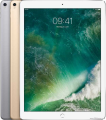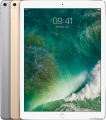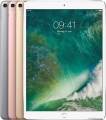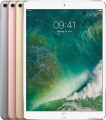Apple iPad Pro 128 GB Prices
Important Note.
- All prices are in Pakistani Rupee (PKR)
- Prices may vary at stores and our effort will be to provide you with the updated prices.
- The latest price of Apple iPad Pro 128 GB was obtained on 17 مئی, 2019. The prices at the original stores had been updated on the respective mentioned dates.
- Find out what tablets price has dropped in Pakistan by selecting Notify Price Drop button
- Find out what tablets has better specifications by clicking Add To Compare Button find out what tablets has better reviews by visiting our reviews section
- Find out what tablets is cheaper on which retailer by clicking Compare prices from retailers button
Search Terms
- Apple iPad Pro 128 GB
Specifications
| GENERAL | |
| 2G Network | GSM 850 / 900 / 1800 / 1900 - Wi-Fi + Cellular model (data only) CDMA 800 / 1900 - Wi-Fi + Cellular model (data only) |
|---|---|
| 3G Network | HSDPA 850 / 900 / 1700 / 1900 / 2100 - Wi-Fi + Cellular model (data only) CDMA2000 1xEV-DO - Wi-Fi + Cellular model (data only) |
| 4G Network | LTE band 1(2100), 2(1900), 3(1800), 4(1700/2100), 5(850), 7(2600), 8(900), 13(700), 17(700), 18(800), 19(800), 20(800), 25(1900), 26(850), 28(700), 29(700), 38(2600), 39(1900), 40(2300), 41(2500) - Wi-Fi + Cellular model (data only) |
| Sim | Nano-SIM/ Apple SIM (US & UK) - Fingerprint sensor (Touch ID) |
| Announced | 10/09/2015 |
| Status | Coming soon. Exp. release 2015, November |
| BODY | |
| Dimensions | 305.7 x 220.6 x 6.9 mm (12.04 x 8.69 x 0.27 in) |
| Weight | 713 g (Wi-Fi) / 723 g (LTE) (1.57 lb) |
| DISPLAY | |
| Display Size | 12.9 inches (~76.4% screen-to-body ratio) |
| Resolution | 2048 x 2732 pixels (~265 ppi pixel density) |
| MultiTouch | Yes |
| Protection | Scratch-resistant glass, oleophobic and antireflective coating - Apple Pencil support |
| SOUND | |
| AlertTypes | N/A |
| LoudSpeaker | Yes, with stereo speakers |
| 3.5mm jack | Yes |
| MEMORY | |
| CardSlot | No |
| Internal | 128 GB, 4 GB RAM |
| DATA | |
| GPRS | Yes |
| EDGE | Yes |
| Speed | HSPA 42.2/5.76 Mbps, LTE Cat4 150/50 Mbps, EV-DO Rev.A 3.1 Mbps |
| WLAN | Wi-Fi 802.11 a/b/g/n/ac, dual-band, hotspot |
| Blue Tooth | v4.0, A2DP, EDR |
| USB | v2.0, reversible connector |
| CAMERA | |
| Camera Primary | 8 MP, 3264 x 2448 pixels, autofocus |
| Camera Features | 1.12µm pixel size, geo-tagging, touch focus, face/smile detection, HDR (photo/panorama) |
| CameraVideo | 1080p@30fps, 720p@120fps, HDR, stereo sound rec. |
| CameraSecondary | 1.2 MP, 720p@30fps, face detection, HDR, FaceTime over Wi-Fi or Cellular |
| FEATURES | |
| OS | iOS 9 |
| Sensors | Accelerometer, gyro, compass, barometer |
| Messaging | iMessage, Email, Push Email, IM |
| Browser | HTML5 (Safari) |
| Radio | No |
| GPS | Yes, with A-GPS, GLONASS (Wi-Fi + Cellular model only) |
| Java | No |
| Colors | Space Gray, Silver, Gold |
| Others | - Apple Smart Keyboard magnetic dock (optional) - Active noise cancellation with dedicated mic - Siri natural language commands and dictation - iCloud cloud service - iCloud Keychain - TV-out - Maps - Audio/video player/editor - Organizer - Document viewer/editor - Photo viewer/editor - Voice memo/dial/command - Predictive text input |
| BATTERY | |
| Battery | Non-removable Li-Po battery |
| TalkTime | Up to 10 h (multimedia) |
| MISC | |
Reviews

Apple kicked off its very busy 2016 with a couple of significant updates to its iPhone and iPad stable in the form of the iPhone SE and the iPad Pro 9.7. Later on this year, Apple will unveil iOS 10, a trio of iPhone 7 models, if the latest rumours are correct, and potentially more iPads and more MacBooks.
Though the new iPad Pro 9.7 was widely expected, what was a bit of a surprise is that, in some respects, the 9.7in iPad Pro is a better version of its bigger counterpart, the 12.9in iPad Pro, which was only released at the end of last year. Both are absolute BEASTS. Just don’t break the damn things as they're next to impossible to repair, according to iFixit, who recently did a tear-down of the iPad Pro 9.7.
“One day, perhaps, Apple will put its massive engineering prowess to work on the problem of how to make a tablet that opens for servicing—without the nail-biting 30-minute process of heating, blind prying, and suctioning it currently demands. But it is not this day.”
- It wasn’t all doom and gloom, though. The blog also highlighted a bunch of areas where the iPad Pro 9.7 really shined, such as:
- “It's refreshing to see a redesign that seems to focus on features rather than a nigh-pointless reduction in thickness, in a device that's already thinner than a pencil.”
- “Apple may have let all the Air out of the iPad line, but they didn't skimp on the Pro 9.7’s specs”
So, with this in mind, how do the existing 12.9in iPad Pro and the new 9.7in iPad Pro compare? We took a look at each to find out.
iPad Pro vs the 9.7in iPad Pro: Specs and Design
12.9in iPad Pro
- Display: 12.9in 2732×2048 pixel at 264 pixels per inch
- Colors: Silver, Space Grey, Gold
- Storage: 32, 128, or 256GB
- Processors: 64-bit A9X and M9
- RAM: 4GB
- Touch ID: yes
- Cameras: front 1.2MP 720p HD camera and a rear 8MP 1080p HD camera
- Connectivity: 802.11a/b/g/n/ac, Bluetooth 4.2, GPS, optional 4G
- Size: 305.7 mm × 220.6 mm × 6.9 mm
- Weight: 713 grams
- Inputs: Lightning, Smart Connector, Apple Pencil
- Speakers: 4
9.7in iPad Pro
- Display: 9.7in 2048x1536 pixel at 264 pixels per inch; True Tone display; Wide colour display
- Colors: Silver, Space Grey, Gold, Rose Gold
- Storage: 32, 128, or 256GB
- Processors: 64-bit A9X and M9
- RAM: 2GB
- Touch ID: yes
- Cameras: front 5MP 720p HD camera and a rear 12MP 4k HD camera with flash
- Connectivity: 802.11a/b/g/n/ac, Bluetooth 4.2, GPS, optional 4G
- Size: 240 mm × 169.5 mm × 6.1 mm
- Weight: 444 grams
- Inputs: Lightning, Smart Connector, Apple Pencil
- Speakers: 4
When it comes to specs, on the surface the two iPad Pro’s look identical in the CPU department. That’s because each have the 64-bit A9X and M9 motion coprocessor. However, Apple has actually underclocked the A9X in the 9.7in iPad Pro, so it runs a bit slower than the A9X in the 12.9in iPad Pro. Tests show the 9.7in iPad Pro runs at 2.16GHz, compared to 2.24GHz for the 12.9in iPad Pro. Will you notice the difference? Probably not, but technically the 12.9in iPad Pro has the faster CPU.
But where you will see a major speed difference is in the RAM department. The 12.9in iPad Pro has that massive 4GB of RAM, but Apple chose to only give 2GB of RAM to the 9.7in iPad Pro. Why, oh, why? Probably because they want to give professionals a reason to pony up for the more expensive, bigger screened iPad Pro.
When it comes to connectivity, storage, and audio, both iPad Pros features exactly the same specs. Each comes in 32, 128, or 256GB configurations, though only the 128 and 256GB models on the 12.9in version offer 4G versions (all storage sizes on the 9.7in iPad Pro offer 4G options). Each also comes with the exact same connectivity when it comes to Wi-Fi and Bluetooth, the same Smart Connector, Apple Pencil support, and the same four speakers.
Besides the display size (which we’ll talk about next) there is one other design difference between the two: the 9.7in iPad Pro comes in the new Rose Gold color option, while the 12.9in still does not. That’s too bad, because Rose Gold rocks.
iPad Pro vs the 9.7in iPad Pro: Display
Of course, the biggest difference between the two iPad Pros are in the display department—but don’t let size fool your. The smaller 9.7in iPad Pro actually has the superior display.
Yes, the 12.9in iPad Pro has the bigger display with the higher resolution (2732×2048 versus the 9.7in’s 2048x1536) but that resolution is only due to the physically larger screen size. Both iPads have the exact same 264 pixels per inch.
The reason the 9.7in iPad Pro has the better display is because its display has built in features including True Tone and wide color built in. Wide color allows for a more vivid color gamut and the True Tone display means the 9.7in iPad Pro’s display will automatically change color based on ambient light in the room, which means it will look more natural—the way paper does when you work on it. this new display technology hasn’t been added to the 12.9in iPad Pro—something that is going to piss off a lot of pro users.
iPad Pro vs the 9.7in iPad Pro: Cameras
The final differences between the 12.9in iPad Pro and the 9.7in iPad Pro are in the camera department. The smaller 9.7in iPad Pro features a better front and rear camera (5MP and 12MP, respectively; and each of these shoot 720p and 4K video, respectively). The rear camera on the 9.7in iPad Pro also has a flash—a first for any iPad. The cameras on the 12.9in iPad Pro are relatively weak in comparison: 1.2MP/720p front and 8MP/1080p rear–and the rear has no flash. The new 9.7in iPad Pro also supports taking Live Photos.
It’s baffling Apple didn’t add these camera improvements to the 12.9in iPad Pro. Again, this is sure to anger a lot of pro users.
iPad Pro vs the 9.7in iPad Pro: Price and Verdict
Here’s the rundown of the various costs for the different models of each iPad Pro:
- 9.7in iPad Pro: 32 GB £499, 128 GB £619, 256 GB £739 (add £100 on for the cellular model).
- 12.9in iPad Pro: 32 GB £679, 128 GB £799, 256 GB £919 (add £100 on for the cellular model).
As you can see, the 12.9in iPad Pro is significantly more expensive than the 9.7in iPad Pro. That extra cost is primarily for the better screen. After all, we know it’s not for the display technology or the cameras—both of which are better in the smaller, cheaper, 9.7in iPad Pro.
So, which should you get? It depends what you want the iPad Pro for. Graphics professionals who are looking for a digital canvas to do their work on—or those looking for a laptop replacement—will probably want to opt for the larger 12.9in iPad Pro. But for those wanting a more portable device with a better display and cameras, the cheaper 9.7in iPad Pro is the way to go.
Write Your Own Review
My Recent Reviews
- Be first to post review for this product.
comments powered by Disqus





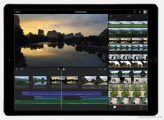
-32-GB.jpg)
